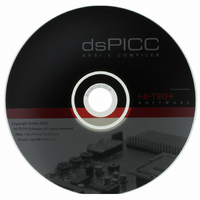SW500009 Microchip Technology, SW500009 Datasheet - Page 114

SW500009
Manufacturer Part Number
SW500009
Description
HI-TECH FOR DSPIC/PIC24
Manufacturer
Microchip Technology
Type
Compilerr
Series
PIC24 & DsPICr
Datasheet
1.SW500009.pdf
(444 pages)
Specifications of SW500009
Supported Families
PIC24
Core Architecture
PIC, DsPIC
Software Edition
Standard
Kit Contents
Software And Docs
Tool Type
Compiler
Mcu Supported Families
PIC24 MCUs And DsPIC DSCs
Lead Free Status / RoHS Status
Not applicable / RoHS Compliant
For Use With/related Products
DSPIC3X/PIC24
Lead Free Status / Rohs Status
Lead free / RoHS Compliant
Other names
025
778-1003
778-1003
778-1003
778-1003
- Current page: 114 of 444
- Download datasheet (3Mb)
HI-TECH C Assembly Language
expands to:
A point to note in the above example: the & character is used to permit the concatenation of macro
parameters with other text, but is removed in the actual expansion.
storage) by opening the comment with a double semicolon, ;;.
comma (or other delimiter such as a space) in an argument then angle brackets < and > may be used
to quote the argument. In addition the exclamation mark, ! may be used to quote a single character.
The character immediately following the exclamation mark will be passed into the macro argument
even if it is normally a comment indicator.
and passed as a decimal number, rather than as a string. This is useful if evaluation of the argument
inside the macro body would yield a different result.
By default, the assembly list file will show macro in an unexpanded format, i.e. as the macro was
invoked. Expansion of the macro in the listing file can be shown by using the EXPAND assembler
control, see Section 4.3.9.2,
4.3.8.20 LOCAL
The LOCAL directive allows unique labels to be defined for each expansion of a given macro. Any
symbols listed after the LOCAL directive will have a unique assembler generated symbol substituted
for them when the macro is expanded. For example:
100
A comment may be suppressed within the expansion of a macro (thus saving space in the macro
When invoking a macro, the argument list must be comma-separated. If it is desired to include a
If an argument is preceded by a percent sign %, that argument will be evaluated as an expression
The nul operator may be used within a macro to test a macro argument, for example:
IF nul
ELSE
ENDIF
down MACRO count
ENDM
LOCAL more
more: decfsz count
goto more
movlf 2,tempvar
movlw 2
movwf tempvar mod 080h
...
...
arg3 ; argument was not supplied.
; argument was supplied
Macro Assembler
Related parts for SW500009
Image
Part Number
Description
Manufacturer
Datasheet
Request
R

Part Number:
Description:
Manufacturer:
Microchip Technology Inc.
Datasheet:

Part Number:
Description:
Manufacturer:
Microchip Technology Inc.
Datasheet:

Part Number:
Description:
Manufacturer:
Microchip Technology Inc.
Datasheet:

Part Number:
Description:
Manufacturer:
Microchip Technology Inc.
Datasheet:

Part Number:
Description:
Manufacturer:
Microchip Technology Inc.
Datasheet:

Part Number:
Description:
Manufacturer:
Microchip Technology Inc.
Datasheet:

Part Number:
Description:
Manufacturer:
Microchip Technology Inc.
Datasheet:

Part Number:
Description:
Manufacturer:
Microchip Technology Inc.
Datasheet:










